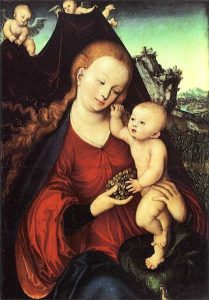“We revere him in the manger, we revere him on the gibbet, we revere him in the tomb. Devoutly do we acknowledge that he was a tender child for our sake, and blood-stained for our sake; we revere him, pallid for our sake, buried for our sake. Devoutly do we adore the Saviour’s infancy along with the wise men, devoutly do we embrace him along with the holy Simeon, as we receive your mercy in the midst of your temple.” Bernard of Clairvaux, “On the Lord’s Birthday, Sermon Five” in Sermons for Advent and the Christmas Season (Kalamazoo: Cistercian, 2007), p. 125. [Emphasis added] 
In this sermon for Christmas Day, Bernard of Clairvaux connects Christian devotion to the Christ-child to Jesus’ suffering, death, and resurrection. This excerpt demonstrates how an increased focus on Christ’s humanity expanded in the 12th century. With his exhortation to devoutly adore the events in the Christ-child’s life, Bernard sought to inspire devotion to the divine Redeemer of sinful humanity. Read how he described the Redeemer in his famous Sermon on the Song of Songs:
“How sweet it is to see as man the Creator of humanity. While he carefully protected nature from sin, he forcefully drove death from that nature also. In taking a body he stooped to me, in avoiding sin he took counsel with himself, in accepting death he satisfied the Father….He took to himself a true body but only the likeness of sin, giving a sweet consolation to weak men in the one and in the other hiding a trap to deceive the devil. To reconcile us to the Father he bravely suffered death and conquered it, pouring out his blood as the price of our redemption.” Bernard of Clairvaux, “Sermon 20. 3” in Song of Songs I (Kalamazoo: Cistercian, 1971), p. 149. [Emphasis added]
